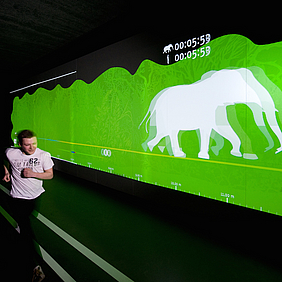Heritage interpretation in exhibitions and museums provides various opportunities for meaningful visitor experiences. These five approaches outline current challenges and future trends for the development of the field.
Location-specific communication in museums
The practice of phenomenon-based communication in museums often focusses on the display and interpretation of exhibits (cf. Veverka 2015). However, the increasing use of scenographic arrangements in exhibitions calls for an exhibition design that is based on the location, i.e. the building. While this is commonly used, taking this approach one step further is not: By identifying the phenomenon using the communication rectangle and developing a theme-centred interaction, the unique potential of the location can not only be translated into an interior design but into a scenography, which is an interactive visitor experience.
From heritage to a sustainable future
While heritage interpretation has the chance to set benchmarks for Education for Sustainable Development (ESD), ESD is at the same time an opportunity to improve the practice of interpretation (Ludwig 2009). It has been argued that ESD is the pedagogic approach for exhibitions and museums in the 21st century (Peter and Garthe 2014). But the intersections between heritage interpretation and museum pedagogics still need to be further excavated. While there are a multitude of great exhibitions on issues about sustainability, sustainability is largely a blind spot within the realm of exhibition development, because concepts and curation are not focused on the key competencies of ESD (cf. Haan 2006). Although not all competencies are equally suitable to be acquired within museums, the future is to develop exhibits that foster competence-based learning. Furthermore, the sustainable production and operation of exhibitions and museums on heritage topics offer opportunities to contribute to a sustainable future (cf. www.ausstellung-museum-nachhaltigkeit.blogspot.de).
Why interpretive centres of protected areas need to be thought from a visitor perspective
An attractive visitor centre is nowadays a must-have for every large protected area. But many of the visitor centres in Germany have a serious problem: They are stuck in environmental education and neglect the anthropocene: With a dramaturgy following habitat types, nature is ‘rebuilt’ within these exhibitions – with often- extensive effort. Thus, too often a visit to the visitor centre effectively replaces a real experience of nature. Developing visitor centres that truly support the mission of Protected Areas would require a radically new approach which puts the human being and its stories in the centre of the concept (Garthe 2017).
The Natural Futures Museum
Heritage interpretation in natural history museums is struggling to find its relevance in the 21st century (cf. Janes 2009). This is why a reconceptualisation of the natural history museum towards a future-oriented institution seems to be necessary. Interaction, participation and object-related interactions that foster a public understanding of collections will be the main instruments to implement this change. In doing so, natural history museums can evolve into the place to address global challenges, discuss the future of the planet and thus increase the relevance for visitors (Garthe 2018).
Exhibitions as an instrument of a Participatory Scientific Society
The potential role of interpretation in a post-fact society has been discussed by Patrick Lehnes, including an article in a previous edition of the IE newsletter(Lehnes 2017). As science and the interpretation of its results are becoming increasingly central to our society, it can be argued that a public understanding of research is becoming essential for democratic cultures. To tackle these challenges, we need to move from a knowledge society to a Participatory Scientific Society, in which interpretation, exhibitions and museums empower citizens to take active ownership in crucial debates. Interpretative activities can support this by not communicating (scientific) themes, but by communicating the research process itself. Successful examples are Open Research Labs, Sciencetainment events, like Worm charming, incorporating transdisciplinary research or Citizen Science programmes, like BioBlitz, or embracing the approaches of the Maker community (cf. Garthe 2015).
Dr. Christopher Garthe develops concepts for exhibitions and visitor experiences. He is Director for Concept Development at studio klv, Fellow of the Working group ‘Heritage Interpretation’ at the Albert-Ludwigs-University Freiburg and consultant for sustainability management in museums and visitor centres. His research is focused on recreation and education in protected areas. He can be contacted at: christopher.garthe@gmx.de
To cite this article:
Garthe, Christopher (2017) ‘Future challenges for interpretation in exhibitions’. In Interpret Europe Newsletter 4-2017, 4-5.
References
Garthe, C., 2015. Using interactive experiences to communicate nature. Gothenburg.
Garthe, C., 2017. Weshalb Naturzentren verhindern, dass Besucher die Natur entdecken [online]. Available from: http://ausstellung-museum-nachhaltigkeit.blogspot.de/2017/05/weshalb-nationalparkzentren-verhindern.html.
Garthe, C., 2018. The Natural Futures Museum: Interactivity and Participation as Key Instruments for Engaging Audiences. In: E. Dorfman, ed. The future of natural history museums. Milton Park Abingdon Oxon, New York NY: Routledge, 140-154.
Haan, G. de, 2006. The BLK ’21’ programme in Germany: a ‘Gestaltungskompetenz’‐based model for Education for Sustainable Development. Environmental Education Research, 12 (1), 19-32.
Janes, R.R., 2009. Museums in a troubled world. Renewal, irrelevance or collapse? London, New York: Routledge.
Lehnes, P., 2017. Interpretation in Darkening Times. Interpret Europe Newsletter (1), 3-4. Available from: https://www.interpret-europe.net/top/news/singlepage-news/news/interpretation-in-darkening-times.html?tx_news_pi1%5Bcontroller%5D=News&tx_news_pi1%5Baction%5D=detail&cHash=676a8bbafb974f12220e77dd3671d463.
Ludwig, T., 2009. ESD as a Chance for the Worldwide Improvement of Interpretation. Athens.
Peter, M., and Garthe, C.J., 2014. Education for sustainable development as a concept for science centres and museums. Engagement for a sustainable future. Spokes (4), 12-17. Available from: http://www.ecsite.eu/sites/default/files/spokes6_0.pdf.
Veverka, J.A., 2015. Interpretive master planning. Strategies for the new millennium, philosophy, theory and practice. Edinburgh: MuseumsEtc Ltd.




